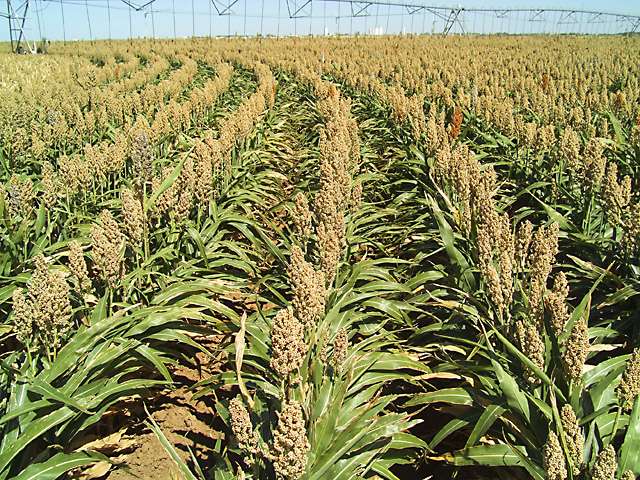


As water becomes more precious in the Texas High Plains, more farmers are likely to turn to sorghum because it’s more drought tolerant than corn and produces higher yields under moderate to severe drought. With recent droughts and water shortages, many farmers have suffered major losses raising corn. The problem is compounded because the region depends on the Ogallala Aquifer for water, which is being depleted. Many farmers’ wells are pumping less water today than in the past.
Farmers need to know if they will get sufficient yields with sorghum if they use deficit irrigation, which is giving the crop less-than-optimal amounts of water. It’s a critical issue in an area where the growing season has erratic rainfall, widely varying temperatures, and extreme weather (hail, flooding, and lightning). Another issue is whether they should raise early-maturing sorghum varieties, which are planted later and are less vulnerable to drought, or late-maturing varieties that have higher yields when given enough water.
Susan O’Shaughnessy, a research agricultural engineer with the Agricultural Research Service’s Soil and Water Management Research Unit in Bushland, Texas, evaluated yields and the water-use efficiency of early- and late-maturing sorghum varieties produced under four deficit irrigation conditions (80 percent, 55 percent, 30 percent, and 0 percent of full water-replenishment levels). “You could consider the 80-percent replenishment level to be mild deficit irrigation, and the lower replenishment levels to be moderate to extreme deficit irrigation,” O’Shaughnessy says.
She and her colleagues planted the late-maturing variety in late May or early June and the early-maturing crop in late June. Both crops were harvested at about the same time in the fall. They grew the crops for three seasons, tracked weather data and rainfall levels, and measured evapotranspiration rates, which is an indicator of the plant’s overall water needs.
In the 2009 and 2010 growing seasons, there was above-average rainfall (7.5 percent and 35 percent above average, respectively), but there was a far lower than average level in 2011 (71 percent less).
They found that on average, over the three growing seasons crop water-use efficiency (the water used by the crop in relation to the crop yield) was typically greatest at the 55-percent replenishment level, but even a 30-percent replenishment at least doubled the yields when compared with no irrigation. At 80-percent replenishment, the late-maturing variety consistently produced higher yields than the early maturing one, but the early-maturing variety produced sufficient yields to make it a viable alternative if a farmer has limited well capacity or if a crop planted earlier in the season (such as corn or cotton) has failed because of hail, floods, or drought.
Growers risk severe or total losses if they practice even moderate deficit irrigation during droughts. In fact, total crop failures are likely without irrigation in drought years like 2011.

